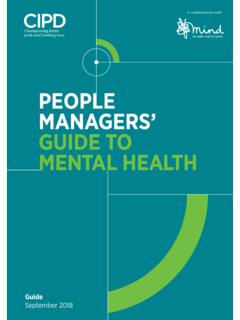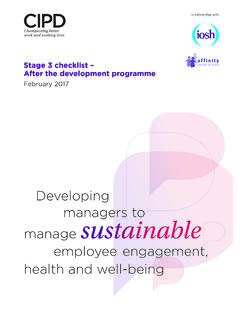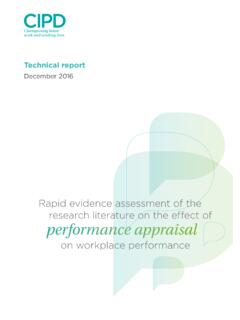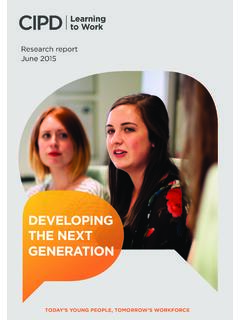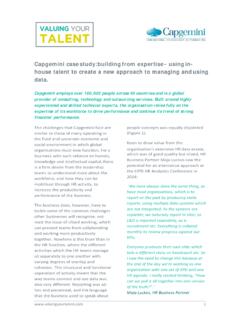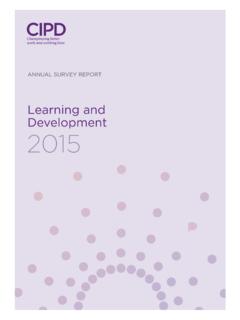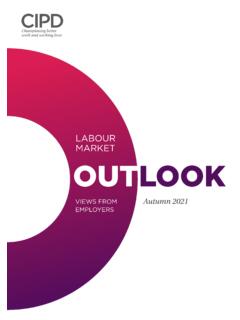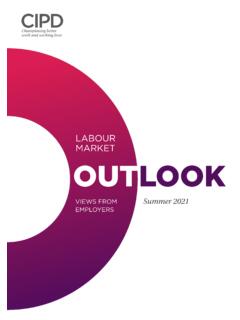Transcription of EMBEDDING NEW WAYS OF WORKING - CIPD
1 Report September 2020 EMBEDDING NEW WAYS OF WORKINGI mplications for the post-pandemic workplaceThe CIPD is the professional body for HR and people development. The registered charity champions better work and WORKING lives and has been setting the benchmark for excellence in people and organisation development for more than 100 years. It has more than 150,000 members across the world, provides thought leadership through independent research on the world of work, and offers professional training and accreditation for those WORKING in HR and learning and development. 1 EMBEDDING new ways of WORKING : implications for the post-pandemic workplace Contents Introduction .. 2 Economic situation and outlook .. 2 Employer response to the pandemic .. 3 WORKING from home .. 7 Creating COVID-secure workplaces.
2 19 Health and wellbeing .. 22 Conclusions and policy recommendations .. 24 Acknowledgements This report was written by Ian Brinkley, Ben Willmott, Mark Beatson and Gerwyn Davies at the CIPD. We would like to thank colleagues who carried out interviews and the many employers who took part in the research for this report. These include the 1,046 establishments that responded to the survey and the 15 organisations that took part in in-depth interviews. In addition, we would like to thank the Department for Business, Energy and Industrial Strategy who helped fund the project. Publication information When citing this report, please use the following citation: CIPD. (2020) EMBEDDING new ways of WORKING : implications for the post-pandemic workplace London: Chartered Institute of Personnel and Development.
3 2 Introduction The COVID-19 pandemic has had a profound impact on the labour market. It has led to a substantial reduction in economic activity, which has substantially reduced demand for labour. Social distancing rules have meant that employers have had to adapt their WORKING practices. In this report we therefore focus on how employers have been reacting to the pandemic during the period to the end of June 2020, by managing workforce costs, for example through freezing recruitment, furloughing staff, redundancies and wage flexibility. However, a major part of the response so far has been an unprecedented shift to homeworking, without which the economic and employment impacts of COVID-19 would have been much more severe. This report shows that there is a high probability that there will be no return to business-as-usual post-crisis.
4 The pandemic has probably changed for good the distribution of work between the regular workplace and home for many workers. This report summarises the results of a special CIPD survey of over 1,000 employers as well as 15 in-depth interviews. Economic situation and outlook The labour market position remains unclear due to official statistics lagging events by two to three months, uncertainties over how reliable the usual measures of unemployment and employment are, and contradictions between a range of indicators including a number of ad hoc surveys by the Office for National Statistics (ONS). In addition, though, there is still a great deal of inherent uncertainty about future prospects, which itself colours the plans and behaviour of both employers and individuals. Policy-makers and analysts are having to piece together a picture from different sources in an unprecedented downturn and with rapidly changing events.
5 What seems to be clear to date is that there was a huge shock in April, with big cuts in hours and jobs and a rapid increase in claims for unemployment-related benefits, but that since then the labour market has been looking more stable, with some indicators such as new unemployment-related claims and redundancies moving back towards pre-COVID-19 levels. It is impossible to say at the moment just how severe and prolonged the downturn will be and what the recovery will look like. The normal uncertainty is compounded because the economic outcome depends very much on the progress in containing the virus. Much will depend on the decisions by individual organisations and businesses between now and the end of 2020 and, for understandable reasons, many employers are still in wait-and-see mode. There is also uncertainty about the outcome of the current negotiations on trade relationships with the EU after Brexit and their likely impact on short-term economic prospects.
6 Most analysts expect a second spike in redundancies in October as the Coronavirus Job Retention Scheme (JRS) comes to an end, but there is little agreement beyond that. The alphabet has been plundered to try to describe the shape of the recovery. Commentators have variously suggested that the current downturn will resemble the recessions of the 1980s, the 1990s or the 2000s, depending on their degree of pessimism. 3 There is widespread agreement that the JRS has broadly achieved its wider objectives of avoiding many redundancies. But some are concerned that the schemes are being withdrawn prematurely, especially for those sectors where government-imposed restrictions severely hamper economic activity. The Government has announced new measures to help employers after the scheme has ended, including some sector-specific measures and a subsidy for new jobs created at NMW rates between now and January 2021.
7 Among some of the reasons for cutting back on the schemes is concern that they will increasingly be propping up jobs that are not viable, wasting cash that could be put to better use supporting jobseekers and disadvantaged groups and encouraging new job formation. In addition, some argue that this downturn was not caused by structural problems such as the financial crisis and therefore recovery will be swifter than previous recessions as restrictions on economic activity are eased. The Government has also stated that it does not envisage a return to austerity which some economists felt delayed the economic recovery after 2010. The CIPD has argued there is a strong case for an extension of the JRS beyond the end of October for sectors such as hospitality, transport and leisure, because whatever the outcome for the economy in general, these sectors will remain badly affected by ongoing restrictions on activity, meaning many businesses will have to continue to operate at a fraction of their normal capacity.
8 Employer response to the pandemic The employer response to the economic impact of the pandemic at the time of the survey in June is similar to the last downturn when organisations used wage flexibility and recruitment freezes to mitigate some of the impact on employment. A major difference is that employers also had the option of placing employees on furlough through the JRS. This has clearly prevented a large number of redundancies, a point underlined by many case studies; but the exact impact is as yet unknown. A summary of employer actions is set out in Table 1. Table 1: Actions by employers in response to the impact of COVID-19 (%) Yes Not yet but planning to No and not planning to Don t know Freeze recruitment 49 2 44 5 Redeployment 42 11 42 5 Make redundancies 11 19 60 10 Increase recruitment 10 9 73 7 Used the JRS/plan to use 52 2 44 2 Seek JRS support next 4 months 41 2 48 9 Freeze/delay wage rises 37 8 44 11 Reduce wages (some or all) 16 7 69 9 Increase wages (some or all) 10 9 71 9 Cut non-wage benefits 7 6 79 9 Shorter WORKING week 19 11 62 8 Increased hours 11 5 78 6 Note: answer to question Which of the following measures, if any, has your organisation taken or is planning to take in response to the impact of the Coronavirus (COVID-19)?
9 N=1,046 4 Recruitment, redeployment and redundancy Many employers have frozen recruitment or are planning to (51%), but significant numbers have not (44%) and some of those who have not have already increased or are planning to increase recruitment (19%). Many organisations also made use of redeployment on a temporary basis within the organisation, reported by 42% of employers and planned by another 11%. Wage flexibility There has been significant wage flexibility in the employer response to date, with 37% of firms saying they had frozen or delayed wage increases and another 8% saying they were planning to do so. Some 16% said they had cut wages for some or all of their staff and another 7% were planning to do so (note that these categories can overlap, as some companies will have delayed wage rises or imposed wage freezes for some staff and cut wages for others).
10 However, relatively few employers have made or are planning to make cuts in non-wage benefits at 7% and 6% respectively. A significant minority said they had or were planning to increase wages for some or all of their staff (overall 19%). Among private sector employers, 48% had frozen or delayed wage increases as had 35% of voluntary sector employers, compared with 9% across the public sector. Similarly, while 20% of private sector employers and 9% of voluntary sector employers had cut wages for some or all of their staff, the share was 2% across the public sector. Wage-freezing was even more widely adopted among JRS-supported employers. Over half (53%) of JRS-supported employers said they had frozen or delayed wage rises for some or all of their staff, with another 10% planning to do so. This compared with 23% and 6% for non-JRS-supported employers respectively.

